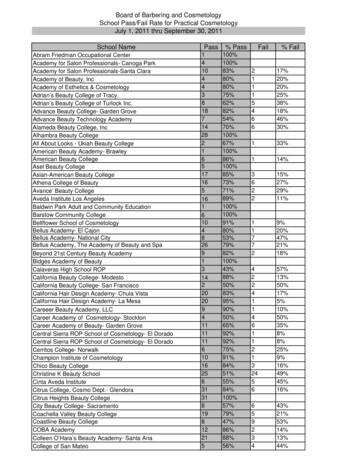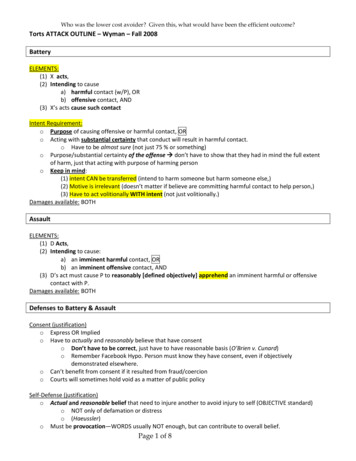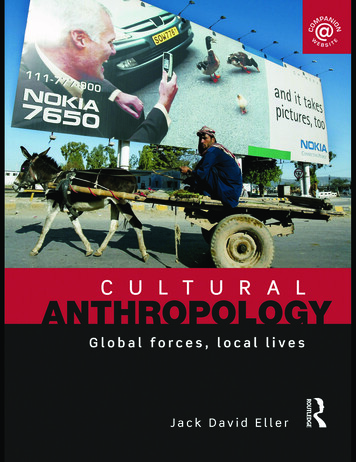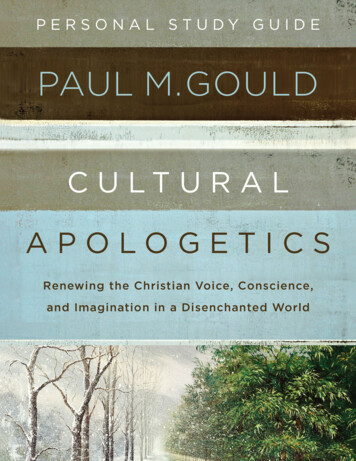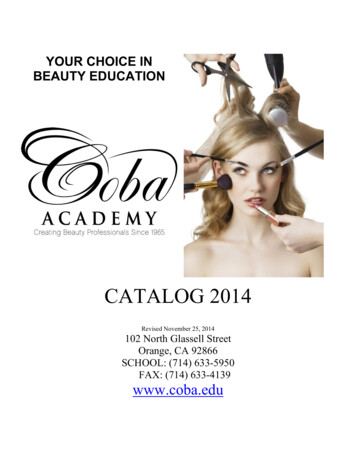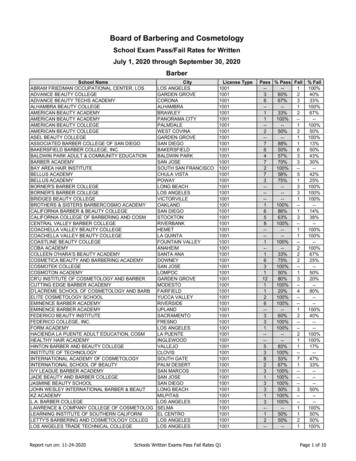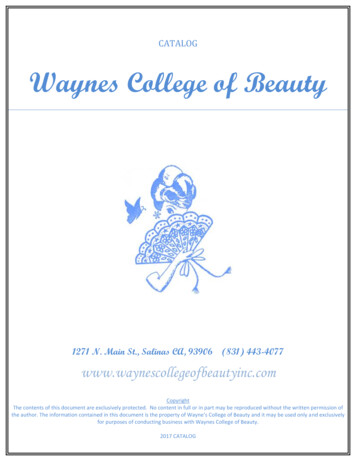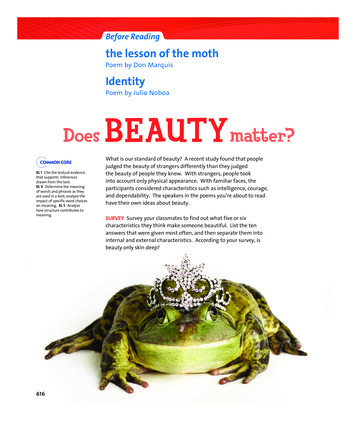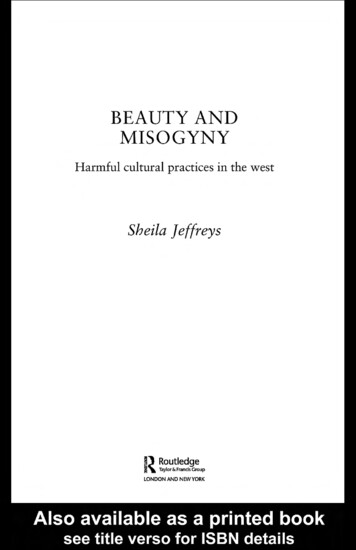
Transcription
BEAUTY AND MISOGYNYShould western beauty practices, ranging from lipstick to labiaplasty, beincluded within the United Nations' understanding of harmful traditional/cultural practices? By examining the role of common beauty practices indamaging the health of women, creating sexual difference, and enforcingfemale deference, this book argues that they should.In the 1970s feminists criticized pervasive beauty regimes such as dietingand depilation, but in the last two decades the brutality of western beautypractices has become much more severe. Today's practices can require thebreaking of skin, spilling of blood and rearrangement or amputation ofbody parts. Some new'' feminists argue that beauty practices are nolonger oppressive now that women can choose'' them. This book seeks tomake sense of why beauty practices are not only just as persistent 30 yearsafter the feminist critique developed, but in many ways more extreme. Byexamining the pervasive use of makeup, the misogyny of fashion and highheeled shoes, and by looking at the role of pornography in the creation ofincreasingly popular beauty practices such as breast implants, genitalwaxing and surgical alteration of the labia, Beauty and Misogyny seeks toexplain why harmful beauty practices persist in the west and have becomeso extreme. It looks at the cosmetic surgery and body piercing/cuttingindustries as being forms of self-mutilation by proxy, in which the surgeonsand piercers serve as proxies to harm women's bodies. It concludes byconsidering how a culture of resistance to these practices can be created.This essential work will appeal to students and teachers of feminist psychology, gender studies, cultural studies, and feminist sociology at bothundergraduate and postgraduate levels, and to anyone with an interest infeminism, women and beauty, and women's health.Sheila Jeffreys is Associate Professor in the Department of Political Scienceat the University of Melbourne where she teaches sexual politics, international feminist politics and lesbian and gay politics. She is the author of ve books on the history and politics of sexuality, and has been active infeminist and lesbian feminist politics since 1973.
WOMEN AND PSYCHOLOGYSeries Editor: Jane UssherSchool of PsychologyUniversity of Western SydneyThis series brings together current theory and research on women and psychology.Drawing on scholarship from a number of different areas of psychology, it bridgesthe gap between abstract research and the reality of women's lives by integratingtheory and practice, research and policy.Each book addresses a cutting edge'' issue of research, covering such topics aspost-natal depression, eating disorders, theories and methodologies.The series provides accessible and concise accounts of key issues in the study ofwomen and psychology, and clearly demonstrates the centrality of psychology todebates within women's studies or feminism.The Series Editor would be pleased to discuss proposals for new books in theseries.Other titles in this series:THIN WOMENHelen MalsonTHE MENSTRUAL CYCLEAnne E. WalkerPOST-NATAL DEPRESSIONPaula NicolsonRE-THINKING ABORTIONMary BoyleWOMEN AND AGINGLinda R. GannonBEING MARRIED DOING GENDERCaroline DrydenUNDERSTANDING DEPRESSIONJanet M. StoppardFEMININITY AND THE PHYSICALLY ACTIVE WOMANPrecilla Y. L. ChoiGENDER, LANGUAGE AND DISCOURSEAnn WeatherallTHE PSYCHOLOGICAL DEVELOPMENT OF GIRLS AND WOMENSheila GreeneTHE SCIENCE/FICTION OF SEXAnnie PottsJUST SEX?Nicola GaveyWOMAN'S RELATIONSHIP WITH HERSELFHelen O'GradyBODY WORKSylvia K. Blood
BEAUTY ANDMISOGYNYHarmful cultural practices in the westSheila Jeffreys
First published 2005by Routledge27 Church Road, Hove, East Sussex BN3 2FASimultaneously published in the USA and Canadaby Routledge270 Madison Avenue, New York NY 10016Routledge is an imprint of the Taylor & Francis GroupThis edition published in the Taylor & Francis e-Library, 2005.“To purchase your own copy of this or any of Taylor & Francis or Routledge’scollection of thousands of eBooks please go to www.eBookstore.tandf.co.uk.”Copyright Ø 2005 Psychology PressAll rights reserved. No part of this book may be reprinted or reproduced or utilized in anyform or by any electronic, mechanical, or other means, now known or hereafter invented,including photocopying and recording, or in any information storage or retrieval system,without permission in writing from the publishers.This publication has been produced with paper manufactured to strict environmentalstandards and with pulp derived from sustainable forests.British Library Cataloguing in Publication DataA catalogue record for this book is available from the British LibraryLibrary of Congress Cataloging-in-Publication DataJeffreys, Sheila.Beauty and misogyny : harmful cultural practices in the West / Sheila Jeffreys.p. cm. (Women and psychology)Includes bibliographical references and index.ISBN 0-415-35182-0 ISBN 0-415-35183-91. Feminine beauty (Aesthetics). 2. Body, Human Social aspects. 3. Women Social life andcustoms. 4. Women Health and hygiene. 5. Women in popular culture. 6. Misogyny. I.Title. II. Series.HQ1219.J44 2005306.4 613 dc222005004366ISBN 0-203-69856-8 Master e-book ISBNISBN 0-415-35183-9 (hbk)ISBN 0-415-35182-0 (pbk)
Beauty and Misogyny is dedicated to my partner, AnnRowett, with my love, and with respect for her lifelong,determined resistance to beauty practices.
CONTENTSAcknowledgementsviiiIntroduction11The grip of culture on the body'': beauty practices aswomen's agency or women's subordination2Harmful cultural practices and western culture283Transfemininity: dressed'' men reveal the naked reality ofmale power464Pornochic: prostitution constructs beauty675Fashion and misogyny876Making up is hard to do1077Men's foot and shoe fetishism and the disabling of women1288Cutting up women: beauty practices as self-mutilationby proxy1495Conclusion: a culture of resistance171References180Index195vii
ACKNOWLEDGEMENTSI am grateful to the Australian Research Council for the large grant thatenabled me to do the research for this book. I was able to employ twowonderful research assistants, Carole Moschetti and Jennifer Oriel, whonot only collected and annotated materials but discussed them with me andmade suggestions. I appreciated their enthusiasm for this project and theirsupport in looking at the sometimes dif cult materials that had to beanalysed.I would like to thank those friends who read and commented helpfullyon the manuscript, Ann Rowett, Heather Benbow, Iva Deutchman. Mystudents in Sexual Politics over the last few years have contributed veryuseful insights about the impact of beauty practices such as high-heeledshoes on their lives and I have enjoyed my discussions with them verymuch.I would like to acknowledge my debt for the ideas in this book to thework of the radical feminist theorist Andrea Dworkin. Her untimely deathin April 2005 was a terrible loss to feminist activism and scholarship. I amvery sad that she will not be able to read this book and know how herideas on beauty practices continue to inspire those who survive her.viii
INTRODUCTIONIn the 1970s a feminist critique of makeup and other beauty practicesemerged from consciousness-raising groups. The American radical feminist theorist Catharine A. MacKinnon called consciousness-raising the methodology'' of feminism (MacKinnon, 1989). In these groups womendiscussed how they felt about themselves and their bodies. They identi edthe pressures within male dominance that caused them to feel they shoulddiet, depilate and makeup. Feminist writers rejected a masculine aestheticsthat caused women to feel their bodies were inadequate and to engage inexpensive, time-consuming practices that left them feeling that they wereinauthentic and unacceptable when barefaced (Dworkin, 1974). Beauty''was identi ed as oppressive to women.In the last two decades the brutality of the beauty practices that womencarry out on their bodies has become much more severe. Today's practicesrequire the breaking of skin, spilling of blood and rearrangement oramputation of body parts. Foreign bodies, in the form of breast implants,are placed under the esh and next to the heart, women's labia are cut toshape, fat is liposuctioned out of the thighs and buttocks and sometimesinjected into other sites such as cheeks and chins. The new cutting andpiercing industry will now split women's tongues in two as well as creatingholes in nipples, clitoris hood or bellybuttons, for the placement of bodyart'' jewellery (Jeffreys, 2000). These developments are much more dangerous prescriptions for women's health than the practices common in the1960s and 1970s when the feminist critique was formed. It might beexpected, then, that there would have been a sharpening of this critique anda renewed awareness of its relevance in response to this more concertedattack on the integrity of women's bodies. But this is not what happened.Instead, the feminist perspective, which caused many thousands of womento eschew beauty culture and products, came under challenge in the 1980sand 1990s.The challenge came from two directions. Liberal feminists, such asNatasha Walter (UK) and Karen Lehrman (USA), argued that there wasnothing wrong with lipstick or women making themselves look good, with1
INTRODUCTIONall the products and practices of beauty culture (Walter, 1999; Lehrman,1997). Feminism itself had created choice for women, they said, andenabled women now to choose'' lipstick where once it might have beenthrust upon them. Meanwhile the in uence of postmodern ideas in theacademy led to some rather similar rhetoric about choice'', usually in theform of agency'', emanating from some feminist theorists and researchers(Davis, 1995). Bolder propositions were made as well, such as the idea thatbeauty practices could be socially transformative. Postmodern feministtheorists such as Judith Butler (1990), with their ideas on gender performativity, inspired the notion among queer theorists that the beauty practices offemininity adopted by unconventional actors, or outrageously, could betransgressive (Roof, 1998). Other postmodern feminists such as ElizabethGrosz argued that the body is simply a text'' which can be written on, andthat tattooing, cutting, let alone lipstick, are just interesting ways of writingon it (Grosz, 1994). It is in response to this recent defence of beautypractices against the feminist critique that this book has been written.In Beauty and Misogyny I suggest that beauty practices are not aboutwomen's individual choice or a discursive space'' for women's creativeexpression but, as other radical feminist theorists have argued before me, amost important aspect of women's oppression. The feminist philosopherMarilyn Frye has written incisively of what makes a theory feminist, andwhy it is not enough to rely on women's individual assurances that apractice is OK with them and in their interests:One of the great powers of feminism is that it goes so far inmaking the experiences and lives of women intelligible. Trying tomake sense of one's own feelings, motivations, desires, ambitions,actions and reactions without taking into account the forces whichmaintain the subordination of women to men is like trying toexplain why a marble stops rolling without taking friction intoaccount. What feminist theory is about, to a great extent, is justidentifying those forces . . . and displaying the mechanics of theirapplications to women as a group (or caste) and to individualwomen. The measure of the success of the theory is just how muchsense it makes of what did not make sense before.(Frye, 1983, p. xi)In this book I attempt to identify some of the forces which maintain thesubordination of women to men'' in relation to beauty practices.I seek to make sense of why beauty practices are not only just aspervasive 30 years after the feminist critique developed, but in many waysare more extreme. To do this I use some new approaches that are suited toexplaining this escalation of cruelty in what is expected of women in thetwenty- rst century. One impetus towards my writing this book lies in my2
INTRODUCTIONgrowing impatience with the western bias of the useful United Nationsconcept of harmful traditional/cultural practices''. In United Nations(UN) documents such as the Fact Sheet on Harmful Traditional Practices'' (UN, 1995), harmful cultural/traditional practices are understood tobe damaging to the health of women and girls, to be performed for men'sbene t, to create stereotyped roles for the sexes and to be justi ed bytradition. This concept provides a good lens through which to examinepractices that are harmful to women in the west such as beauty practices.But western practices have not been included in the de nition or understood in international feminist politics as harmful in these ways. Indeedthere is a pronounced western bias in the selection of practices to t thecategory such that only one western practice, violence against women, isincluded (Wynter et al., 2002). The implication is that western cultures donot have harmful practices such as female genital mutilation that shouldcause concern. I argue in Beauty and Misogyny that western beauty practices from makeup to labiaplasty do t the criteria and should be includedwithin UN understandings. The great usefulness of this approach is that itdoes not depend on notions of individual choice; it recognizes that theattitudes which underlie harmful cultural practices have coercive powerand that they can and should be changed.Another approach I use is to look at men's involvement in two ways inthe beauty practices of femininity: in transvestism/transsexualism, and inthe role of designers and photographers in the fashion industry. There areuseful clues to the cultural meanings of feminine beauty practices, andthe ways in which they are enforced, to be gleaned from looking at thebehaviour of the men who practise them and the men who design them. Iuse insights gleaned from books and Internet resources aimed at men whogain sexual excitement from appropriating a form of femininity for themselves. In the decades since the 1970s the male practice of transvestism/transsexualism, that is, appropriating clothes or body parts usually allottedto members of the subordinate sex class under male supremacy, has gainedmuch wider public exposure and in uence. The Internet has enabledthe websites of individual practitioners and support groups, as well ascommercial makeover sites and pornography devoted to these masculinepractices, to proliferate. This provides a good opportunity to show that feminine'' beauty practices are neither natural, nor con ned to women.There is also much useful information about what such practices representfor men, the sexual excitement of ritualized subordination. I make use ofsuch websites in several chapters, analysing the creation of femininity bymen or transfemininity''. With the insight that such an analysis offersI argue that this practice of men is in uential in the construction of harmful beauty practices for women through the in uence of male fashiondesigners, fashion photographers and makeup artists who have vestedinterests in transfemininity.3
INTRODUCTIONAnother approach I use to investigate beauty practices is an analysis ofthe in uence of the pornography and prostitution industries in theircreation. I suggest that in the late twentieth century, the growth of theseindustries had a considerable effect on the beauty practices that are requiredof women. As these industries have moved above ground and becomerespectable, through the development of new technologies such as theInternet, and laissez-faire government policies, the cultural requirements forthe construction of beauty have changed. The stigmata of sexual objecti cation for sale have become de rigeur in the beauty industry. Pressuresfrom pornography have created new fashion norms for women in general,such as breast implants, genital waxing, surgical alteration of labia, thetrappings of sadomasochism in the form of black leather and vinyl, andthe display of increasing amounts of esh including naked breasts andbuttocks.Beauty and Misogyny concludes with a chapter on the degree of seriousphysical harm to women and some categories of men that has now becomenormalized through the sex industry, through celebration in art andfashion circles and through Internet networks. This harm, I suggest, needsto be understood as self-mutilation by proxy. It includes cosmetic surgeryin which the proxies are cosmetic surgeons, and the cutting and piercingindustry in which the proxies are to be found in piercing studios. From the1990s onwards it has included extremely severe practices such as limbamputation for which the proxies are surgeons and other practices ofsadomasochism in which body parts are removed. Some of these practicesare suffered by vulnerable categories of gay men as well as by women.There does not seem to be a limit to the varieties of cutting up thatmembers of the medical profession are prepared to engage in for pro t.The defence of the consent'' of the victim is being employed in suchdubious circumstances that the whole notion of consent must be throwninto doubt. I argue that, consent notwithstanding, limits should be constructed to the swathe of attacks on the integrity of women's and somemen's bodies in the name of beauty or dissatisfaction with appearance thatare taking place in the early twenty- rst century.4
1THE GRIP OF CULTURE ONTHE BODY''*Beauty practices as women's agency or women'ssubordinationIn the 1990s a fundamental disagreement emerged between feministscholars regarding the extent to which western beauty practices representwomen's subordinate status or can be seen as the expression of women'schoice or agency. Ideas emerge in particular time periods because of aconcatenation of social forces that make them possible. In the 1960s and1970s the new social movements of feminism, black power, animal liberation, lesbian and gay politics came into being in response to a mood ofhopefulness about the possibility of social change. These social movementswere fuelled by a belief in social constructionism and the idea that radicalsocial transformation was possible in the pursuit of social equality. Theseideas underpinned the thoroughgoing radical feminist critiques of beautythat emerged from that period.In the 1980s, however, the ideas of radical feminism, like those of othersocially transformative ideologies, were treated to the contempt of rightwing ideologues who called them political correctness''. A new ideologyof market fundamentalism was developed to provide the ideologicalsupport for the expansion of a newly deregulated rogue capitalism. Thisstated that the free market, controlled only by the choices of empoweredcitizens, would create an ideal social and economic structure withoutinterference from the state. Citizenship, in this new worldview, was notabout rights but about responsibilities, and the citizen was empowered byconsumer choice (Evans, 1993).By the 1990s these ideas about the power of choice in uenced thethinking of many feminists too. The idea that women were coerced intobeauty practices by the fashion/beauty complex (Bartky, 1990), forinstance, was challenged by a new breed of liberal feminists who talkedabout women being empowered by the feminist movement to choosebeauty practices that could no longer be seen as oppressive. The newlanguage that penetrated feminist thinking from the pervasive rightwingrhetoric was that of agency'', choice'' and empowerment''. Women* Bordo (1993, p. 117).5
THE GRIP OF CULTURE ON THE BODY''became transformed into knowledgeable consumers who could exercisetheir power of choice in the market. They could pick and choose frompractices and products. Feminists who continued to argue that women'schoices were severely constrained and made within a context of women'srelative powerlessness and male dominance were criticized with someacerbity as victim feminists''; that is, making women into victims bydenying their agency (Wolf, 1993).In this chapter I examine the ideas of the radical feminist critique ofbeauty and show how these came to be challenged both by the new liberalfeminism and by its counterpart in the academy, a variety of postmodernfeminism that emphasizes choice and agency in a similar way. I considerthe tensions that have developed between the advocates of choice'' andthose who emphasize the role of culture and force in exacting women'sconformity to the beauty practices of femininity. I conclude with the ideasof some of those feminist theorists and researchers who have providedpersuasive explanations of the constraints that restrict the possibilities ofwomen's agency around beauty practices in male dominant culturesfounded on sexual difference/deference.THE FEMINIST CRITIQUE OF BEAUTYFeminist critics of beauty have pointed out that beauty is a cultural practiceand one that is damaging to women. For writers such as Andrea Dworkinthe most important question was not the extent to which women couldexpress agency and choose'' to wear makeup but what harm beautypractices did to women. Her book Woman Hating is a good example ofthe powerful critique that radical feminists were making of the notionof beauty in the 1970s (Dworkin, 1974). She analyses the idea of beauty''as one aspect of the way women are hated in male supremacist culture.Dworkin indicts woman-hating culture for, the deaths, violations, andviolence'' done to women and says that feminists, look for alternatives,ways of destroying culture as we know it, rebuilding it as we can imagineit'' (1974, p. 26).Dworkin sees beauty practices as having extensive harmful effects onwomen's bodies and lives. Beauty practices are not only timewasting,expensive and painful to self-esteem, but rather:Standards of beauty describe in precise terms the relationship thatan individual will have to her own body. They prescribe hermobility, spontaneity, posture, gait, the uses to which she can puther body. They de ne precisely the dimensions of her physicalfreedom.(Dworkin, 1974, p. 112, emphasis in the original)6
THE GRIP OF CULTURE ON THE BODY''And, she continues, beauty standards have psychological effects on womentoo because the relationship between physical freedom and psychologicaldevelopment, intellectual possibility, and creative potential is an umbilicalone''. Dworkin, like other radical feminist critics of beauty, describes thebroad range of practices that women must engage in to meet the dictates ofbeauty:In our culture, not one part of a woman's body is left untouched,unaltered. No feature or extremity is spared the art, or pain, ofimprovement. Hair is dyed, lacquered, straightened, permanented;eyebrows are plucked, penciled, dyed; eyes are lined, mascaraed,shadowed; lashes are curled, or false from head to toe, everyfeature of a woman's face, every section of her body, is subject tomodi cation, alteration.(Dworkin, 1974, p. 112)Interestingly this list omits cosmetic surgery, and that would not makesense today. This shows the progress there has been in making cosmeticsurgery simply another form of makeup in the 30 years since Dworkinembarked on her analysis (Haiken, 1997). The other oppressive elements ofbeauty that Dworkin remarks on are that it is vital to the economy'' and the major substance of male female role differentiation, the mostimmediate physical and psychological reality of being a woman'' (Dworkin,1974, p. 112). Beauty practices are necessary so that the sexes can be toldapart, so that the dominant sex class can be differentiated from the subordinate one. Beauty practices create, as well as represent, the difference''between the sexes.Sandra Bartky, who also developed her ideas in those heady days of the1970s when profound critiques of the condition of women included ananalysis of beauty, addressed the issue of why women could appear to choose''. She explains why no exercise of obvious force was requiredto make women engage in beauty practices. It is possible'', she says, tobe oppressed in ways that need involve neither physical deprivation, legalinequality, nor economic exploitation; one can be oppressed psychologically'' (Bartky, in a collection of previously published pieces, 1990, p. 23).In support of this she utilizes the work of the anti-colonial theorist FrantzFanon who wrote of the psychic alienation'' of the colonized. Thepsychological oppression of women, Bartky says, consists of women being stereotyped, culturally dominated, and sexually objecti ed'' (1990, p. 23).She explains this cultural domination as a situation in which, all the itemsin the general life of our people our language, our institutions, our artand literature, our popular culture are sexist; that all, to a greater orlesser degree, manifest male supremacy'' (1990, p. 25). The absence of anyalternative culture within which women can identify a different way to be7
THE GRIP OF CULTURE ON THE BODY''a woman enforces oppressive practices, The subordination of women,then, because it is so pervasive a feature of my culture, will (if uncontested)appear to be natural and because it is natural, unalterable'' (1990, p. 25).The bedrock of this cultural domination is the treatment of women assex objects and the identi cation of women themselves with this culturalcondition. Bartky (1990) de nes the practice of sexual objecti cation thus: a person is sexually objecti ed when her sexual parts or sexual functionsare separated out from the rest of her personality and reduced to the statusof mere instruments or else regarded as if they were capable of representingher'' (p. 26). Women incorporate the values of the male sexual objecti erswithin themselves. Catharine MacKinnon calls this being thingi ed'' inthe head (MacKinnon, 1989). They learn to treat their own bodies asobjects separate from themselves. Bartky explains how this works: the wolfwhistle sexually objecti es a woman from without with the result that, The body which only a moment before I inhabited with such ease now oods my consciousness. I have been made into an object'' (Bartky, 1990,p. 27). She explains that it is not suf cient for a man simply to look at thewoman secretly, he must make her aware of his looking with the whistle.She must, be made to know that I am a nice piece of ass': I must be madeto see myself as they see me'' (p. 27). The effect of such male policingbehaviour is that, Subject to the evaluating eye of the male connoisseur,women learn to evaluate themselves rst and best'' (Bartky, 1990, p. 28).Women thus become alienated from their own bodies.The fashion beauty complex'', representing the corporate interestsinvolved in the fashion and beauty industries, has, Bartky argues, takenover from the family and church as central producers and regulators of femininity' '' (1990, p. 39). The fashion beauty complex promotes itself towomen as seeking to, glorify the female body and to provide opportunities for narcissistic indulgence'' but in fact its aim is to depreciatewoman's body and deal a blow to her narcissism'' so that she will buymore products. The result is that a woman feels constantly de cient andthat her body requires either alteration or else heroic measures merely toconserve it'' (p. 39).Dworkin and Bartky produced their critiques of beauty in the 1970s andearly 1980s. The most powerful feminist work on beauty to be publishedsince then, Naomi Wolf's The Beauty Myth (1990) provides an interestingexample of how the times had changed. Despite, or perhaps because of, thepower of her critique, Wolf felt it necessary to publish within 3 yearsanother book, Fire with Fire (1993), which substantially removed the stingfrom her analysis and set out to distinguish her from the ranks of radicalfeminists. Wolf argues that women are required to engage in beauty practices and that this requirement was tightened in the 1980s as a backlashagainst the threat of the women's liberation movement and the greateropportunities, particularly in the workforce, that women were now8
THE GRIP OF CULTURE ON THE BODY''accessing. As she explains, The more legal and material hindranceswomen have broken through, the more strictly and heavily and cruellyimages of female beauty have come to weigh upon us'' (1990, p. 10).Wolf's analysis suggests that women are coerced into beauty practices byexpectations of women in the workplace. Women might have enteredworkplaces in great numbers in the 1970s but in order not to threaten men,and in order to meet the requirement that they should be objects for thesexual delight of their male colleagues, they were required to engage inpainful, expensive and time-consuming procedures that were not expectedof their male counterparts if they wanted to get jobs and keep them. Therewas a professional beauty quali cation'' which accompanied women intothe workplace. Interestingly, despite the strength of Wolf's critique ofbeauty practices she does not consider them to be harmful in their ownright, but only if they are forced on women rather than freely chosen''.In her last chapter Beyond the Beauty Myth'' she asks Does all thismean we can't wear lipstick without feeling guilty?'' (1990, p. 270); thenanswers, On the contrary''. She explains:In a world in which women have real choices, the choices we makeabout our appearance will be taken at last for what they really are:no big deal.Women will be able thoughtlessly to adorn ourselves with prettyobjects when there is no question that we are not objects. Womenwill be free of the beauty myth when we can choose to use ourfaces and clothes and bodies as simply one form of expression outof a full range of others.(Wolf, 1990, p. 274)Wolf's analysis does not suggest that there is a problem with the
It is in response to this recent defence of beauty practices against the feminist critique that this book has been written. In Beauty and Misogyny I suggest that beauty practices are not about women’s individual choice or a ‘‘discursive space’’ for women’s creative expression but, as other radical feminist theorists have argued .File Size: 919KBPage Count: 215
